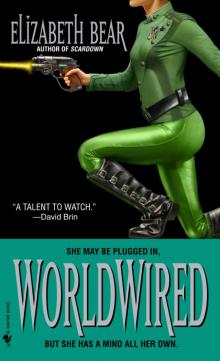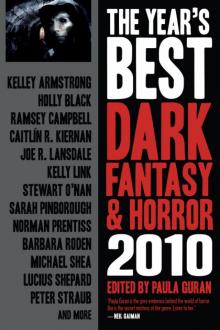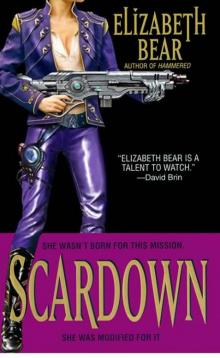- Home
- Elizabeth Bear
Some of the Best from Tor.com: 2012 Edition: A Tor.Com Original Page 6
Some of the Best from Tor.com: 2012 Edition: A Tor.Com Original Read online
Page 6
Until Madame de Lafontaine’s carriage stopped and the wolf let out a mental howl so loud that Ritter was almost surprised when the lady herself showed no signs of hearing it. “If you would please step out of the carriage, milady,” he said. “This is only a formality.”
She alit. “All this fuss, simply to meet me?” Madame de Lafontaine said in an amused tone. Coquettishly, she pointed her fan toward his chest.
Without warning, Geri leaped, snarling, at the woman. Ritter thrust himself into the wolf’s mind, merging identity with it, all but becoming the wolf, trying to bring him under control. But before he could, a puff of smoke appeared at the tip of the fan. Agonizing pain washed through him as a bullet penetrated Geri’s brain.
The wolf, though dead or dying, was carried onward by momentum, and his body knocked over Madame de Lafontaine. Clutching his own head, Ritter also fell to the ground.
It was from a prone position that, uncomprehending, he saw Sir Toby walk toward the fallen woman, pistol in hand. Her eyes widened in shock as he pointed it at her.
Sir Toby fired.
In an instant, Madame de Lafontaine’s appearance changed. Gone was the beautiful young Frenchwoman, replaced not by an older version of herself but by an equally young woman with short black hair and sharp features—a glamour-wielder, like Madame de Lafontaine, but in the service of a different master. The fan she held was now revealed to be a pistol.
All this Ritter saw in the instant before he passed out.
At sunrise, the mountaintop erupted in fire and ceased to be. Everyone in the village below, standing in the streets to watch, threw up their arms to block the sight and turned away from its fury. When Ritter could see again, there was a luminous cloud of smoke and ash rising from what had been Schloss Greiffenhorst. Coalescing in the heart of the fire, a mighty firebird slowly took form. It started to move its tremendous wings even before they were complete. Then, over the course of several minutes, it broke free of the rising cloud and began the long flight back to its ancestral homelands in the East.
“A terrifying sight,” Ritter said at last.
“There are worse to come,” Sir Toby replied. “I arrived at the conference late because, by a special dispensation of your Emperor Rupert, I had arranged an interview with the Wittenberg Sibyl. She foresees cities destroyed, farmlands blasted, the slaughter of millions in a pointless and genocidal war. This she told me in great and horrifying detail.”
“But surely that is only a possible future,” Ritter said. “As I understand it, the Sibyl always offers two contradictory predictions, one much darker than the other.”
“You don’t understand. What I told you was the good outcome. The one where, after terrible suffering, the Mongolian Wizard and his evil empire are defeated. The alternative—well, I do not care to speak of the alternative.”
They stood in silence for a time, watching the cloud over the mountain rise and then spread, like a tremendous mushroom. At last Sir Toby said, “I am sorry your wolf died.”
“Geri was a soldier, like me. When one is a soldier, it is occasionally one’s duty to die.”
“I understand that necessity, but I still regret each death. Today, before I sleep, I must write to the families of forty soldiers, informing them of their loved one’s heroism—and of his death. Believe me, I understand your loss.”
“Thank you.”
“They tell me you have a second wolf, almost fully trained. How long before he is fit for service?”
“Freki should be ready in three weeks. Why do you ask?”
“Because you’re working for me now.”
Ritter turned to face the English wizard. “Eh?”
“I intend to ask your uncle to arrange for your government to lend you to me under extended leave. After all this—” Sir Toby gestured up at what had been the mountaintop “—I don’t see him refusing me much of anything.”
“But…why me?”
“You’re smart, you’re skeptical, and with a little encouragement I believe you could be ruthless. Also, I’ve recently lost one of my best agents. I have an opening.” Sir Toby placed a hand on Ritter’s shoulder and squeezed briefly. “Welcome to the British Secret Service, son. Now, if you’ll excuse me, I have letters to write.”
Ritter watched the enormous man walk away and, as he did, could not help but wonder.
There was only one individual who would have benefited from the phoenix’s birth while the conference was in full session—the Mongolian Wizard. The act would have killed half the leadership of lands he was sure to invade soon. Seen that way, the attempted sabotage had backfired. Those same lords and wizards who could not get along with each other would now assuredly set aside their differences to form a cohesive alliance against the common enemy whose ruthlessness had just been so vividly demonstrated.
However…
However, looked at another way, as an act of sabotage that was intended to fail, suspicion must necessarily fall a little closer to home.
Though the sun had risen, the morning was still bitter cold. A wind blew up and went right through his clothing, chilling him to the bone. Sir Toby had said that his best agent had died recently. Ritter could not help thinking of the look of shock on the face of the glamour-wielder when Sir Toby shot her. Shock, possibly, at his betrayal? Her body had been left on the mountaintop. There could be no identifying it now. No way that Ritter could ever know if his dark supposition were true.
Yet, even if it were, could he entirely condemn his new master for an act whose repercussions were surely for the good? Forty-one deaths weighed against millions. Sir Toby valued tough-mindedness above all things. To him, that was the kind of calculation that solved itself.
Dark days were ahead, and he was going to be a part of them. Ritter fervently hoped he would never reach the point where such a sacrifice would seem to him a sensible thing.
But he rather suspected that he would.
Copyright (C) 2012 by Michael Swanwick
Art copyright (C) 2012 by Gregory Manchess
Books by Michael Swanwick
The Dragons of Babel
Bones of the Earth
Jack Faust
The Iron Dragon’s Daughter
Griffin’s Egg
Stations of the Tide
Vacuum Flowers
In the Drift
SHORT STORY COLLECTIONS
The Dog Said Bow-Wow
The Periodic Table of Science Fiction
Cigar-Box Faust and Other Miniatures
A Geography of Unknown Lands
Gravity’s Angels
Moon Dogs
Puck Aleshire’s Abededary
Tales of Old Earth
The author and publisher have provided this e-book to you without Digital Rights Management software (DRM) applied so that you can enjoy reading it on your personal devices. This e-book is for your personal use only. You may not print or post this e-book, or make this e-book publicly available in any way. You may not copy, reproduce or upload this e-book, other than to read it on one of your personal devices.
Copyright infringement is against the law. If you believe the copy of this e-book you are reading infringes on the author’s copyright, please notify the publisher at: us.macmillanusa.com/piracy.
Contents
Begin Reading
This is true, I swear:
I was in Orlando in October, staying in one of those big, bland conference hotels. DARPA, the Pentagon department tasked with nurturing Mad Science in all its most speculative forms, had decided to throw a brainstorming conference on the 100 Year Starship—a mind-meld to try and figure out what research they’d have to conduct in order to have a hope of beginning to build a starship some time in the twenty-second century. And for no reason I clearly understood, they decided to fly in a bunch of SF authors from all over the world. I’m not sure why the Pentagon might want a starship, but I was glad someone was paying for me to go to Orlando and kibitz on their conference, and I was happy to blo
viate about such things from a hard SF point of view.
The 100YSS conference exceeded all my expectations—and everyone else’s. But the sheer amount of information on tap made the experience feel a bit like trying to drink from a fire hose. It turns out there’s a lot we don’t know about how to build a starship, but also a lot that we do know, and this was the mother of all networking opportunities for folks with an interest in the field.
Like all networking sessions, a lot of the interesting stuff happens among small groups by the poolside bar, or over a dinner table in a nearby restaurant. You get talking to some interesting-sounding folks who ply you with beer, and the next thing you know you discover you’ve been drafted into some kind of DARPA-funded think tank, or wake up with a hangover in a North Korean labour camp, doomed to spend the next two years coaching the Great Leader’s son through writing the Nobel Prize–winning SF novel that daddy expects him to produce.
Luckily that’s never happened to me, but I have had an eye-opening experience or two. Like the chat I had on Sunday evening by the swimming pool.
The Orlando conference center where they held the 100 Year Starship event had a resort-grade outdoor water attraction. Not only were there hot tubs and a regular swimming pool and a water slide, this hotel had an artificial river about a quarter of a mile long, down which you could drift along on a truck tire, propelled by aquajets and drenched by fountains. On a muggy October evening, after a long day of listening to talks about liquid indium ion drives and aneutronic boron fusion reactors, this was exactly the right place to hang out if you wanted to bump into inebriated floating rocket scientists. Like Greg Benford’s twin brother, Jim.
You probably know Greg Benford best as a physicist and hard SF writer, one of the “Killer B’s” who dominated the field in the 1980s and who is still actively writing novels and research papers. But you might not be aware that Greg has an identical twin, or that his sibling Jim is a card-carrying rocket scientist. Back in 2011, Jim was doing impressive things with microwave sails, and Greg was talking up the applications of a lot of recently declassified Russian research into nuclear thermal rockets: “They built this underground test complex near Semipalatinsk, so that they could capture the exhaust. And then they ran their motor for nearly five hundred hours. That’s about a thousand times longer than Project NERVA managed, in total—in one burn! It’s safe, and it’s reliable, and it’s the best way of getting to the outer planets.” His tire spun slowly round as he drifted under one of the fountains, and because we were orbiting near opposite sides of the artificial river, our paths diverged. Intrigued, I paddled to catch up.
“Don’t you think launching a nuclear reactor might be a bit problematic?” I asked, as I closed to within hailing distance. “I mean, the antinuclear protests when Cassini launched…”
Jim waved dismissively. “It’s safe as houses,” he assured me. “You’re looking for safety, right? Nuclear thermal, you launch the reactor fuel piecemeal in Soyuz or Dragon capsules with a man-rated launch escape system, then fuel the reactor once it’s in orbit. No, nuclear-thermal is fine. Not very efficient, but it’s not going to kill anyone. If you want efficient propulsion technology, you’ve got to look elsewhere. But unfortunately the best rocket tech we know of is far too dangerous to use.”
“How dangerous?”
Jim winked at me. “Let me introduce you to Leonard,” he said as we drifted toward the poolside cocktail bar. “He’ll fill you in on it…”
Leonard Hansen—not his real name—is a tanned seventy-something rocket scientist who spent the 1950s in California and New Mexico, as a graduate student researching rocket fuels under John D. Clark and then as a fuels scientist working on various missile programs. Today he lives in semiretirement in Florida, but he retains a keen interest in the field of rocket fuel design.
“What you need to understand is that in order to go faster, you need to increase the exhaust velocity,” he explained. “You can do this by making it much hotter, or by using lighter exhaust particles. If you want to make it hotter, however, you need to pump more energy into it. So if you’re using chemical rockets, you need to use very energetic reagents—fuel and oxidizer.”
He paused for a mouthful of lime margarita. “Take the space shuttle,” he said wistfully. “With just two tweaks, we could have put a hundred tons into its payload bay!”
“Two tweaks?” I asked doubtfully. A hundred-ton payload (in a vehicle already massing close to a hundred tons) would have put the shuttle in the same bracket as the Saturn V.
“Yes.” He smiled sourly. “They could have stretched it, given it a bigger thermal protection system as well—the Columbia disaster wouldn’t have happened. But they rejected my proposal. The first part, to upgrade the SRBs, would have been trivially easy! Although the alternate oxidizer for the space shuttle main engines would have presented certain handling difficulties, that much is true…”
“Tell him about the SRBs first,” Jim suggested. He leaned forward expectantly; at a guess, he’d heard this before.
“All right. First, the solid rocket boosters. Regular SRBs run on a mixture of ammonium perchlorate—the oxidizer—and finely powdered aluminum, suspended in a rubbery polymer that holds everything together and provides additional reaction mass. When they ignite you get aluminum oxide and ammonium chloride and lots of energy. But it’s not really enough! We could make them about twenty percent more efficient if we just replaced the aluminum with powdered beryllium. It’s a lighter atom and the redox reaction is more energetic—”
“Hang on!” I stared at him. “Beryllium is really poisonous. Wouldn’t that—”
Leonard shook his head. “Nonsense.” A small smile. “You see, then there was my second proposal. If you replace the oxidizer in the space shuttle main engines with liquid fluorine, you could also get an extra twenty percent out of them. And I know what you’re going to say next: wouldn’t that give rise to an exhaust plume of extremely hot hydrofluoric acid? You’re absolutely right: it would! But hydrofluoric acid reacts with beryllium oxide to give you beryllium fluoride—which is almost inert in comparison—and hydrochloric acid, which is neither here nor there.” A shadow crossed his face. “It’s totally safe, compared to some of the other projects I’ve worked on. But NASA took one look at the environmental impact statement and, and…” His shoulders began to shake; whether with laughter or tears, I couldn’t tell.
Now, I have a background in chemistry. And I think I should explain at this point that liquid fluorine is not your friend. Fluorine is the most active elemental oxidizing agent in the periodic table, and liquid fluorine makes liquid oxygen look inert and unreactive. It likes to oxidize things we don’t usually think of as oxidizable, like water—which it reacts with to product hydrofluoric acid, which is in turn nasty enough that sane people avoid working with it because if you forget for one second what you’re dealing with it’s liable to dissolve your bones.
Back in the nineteenth century, chemists used to joke that you could tell who had just discovered elemental fluorine by reading the obituary columns. But liquid fluorine and hydrofluoric acid are themselves not the worst oxidizing agents out there. Elemental fluorine may be the thuggish hit-man of the halide world, but if you torment it with chloride ions you can turn it into the chemical equivalent of Hannibal Lecter: chlorine trifluoride, an oxidizing agent so malignant that it will set fire to water and burn explosively on contact with sand, asbestos, or rocket scientists.
Jim Benford smiled. “Now why don’t you tell him about the proposal for NAIL SPIKE?”
“What?” Leonard looked confused for a moment. “I thought he’d be more interested in D-SLAM—”
“Wasn’t that Project PLUTO?” I asked. I’m enough of a crazy cold war projects geek to have heard of the atomic powered cruise missile—a device that only Dr. Strangelove could have loved—from the 1960s.
“Yes, D-SLAM was PLUTO,” said Jim. “But it’s not that interesting, unless you want a power source for a dron
e that can explore the atmosphere of Jupiter for years at a time. NAIL SPIKE, on the other hand—”
“NAIL SPIKE was a CIA project.” Leonard polished off his cocktail and put the glass down on the bar, just loudly enough to get my attention. He caught my eye. I sighed, and waved at the bartender.
“Are you supposed to be talking to me about it, then?” I asked. “Me being a foreigner, remember?” Not that I wasn’t curious, but I wasn’t particularly enthusiastic about unintentionally having my stay in the US extended by a few years due to someone else’s loose lips.
“Oh, it’s old hat.” Jim waved my question away. “We’re talking about 1970s projects here. It was declassified in the 90s, after the end of the cold war.”
“The CIA were into rocketry?” I couldn’t help myself.
“After a fashion.” Our new round of drinks arrived. Leonard took a cautious sip of his. “Who was that writer friend of yours, Jim, from California…?”
“Larry, Larry Niven. ‘Any reaction motor is a weapon of efficiency proportional to its efficiency as a rocket.’ That’s what you were thinking of?”
“Yes, that’s the one. He was spot-on, you know. NAIL SPIKE was about building a really efficient rocket motor and then marketing it to the opposition.”
“Wait, what?” (I can’t easily describe the experience of involuntary nasal irrigation with a lime margarita, so I won’t bother. Just try not to do it.)
When I stopped convulsing Leonard continued: "The idea is quite simple. During the 1940s and 1950s we experimented with a number of really quite unpleasant substances before settling in the 1960s on a handful of slightly less unpleasant stuff as our propellants of choice—liquid oxygen, liquid hydrogen, kerosene, and solids based on powdered aluminum. Of course, there were exceptions; Titan ran on dinitrogen tetroxide and a hydrazine/UDMH mixture, for example. Hydrazine isn’t just explosive, it’s corrosive and poisonous too. There’s a reason the EPA-bullied wimps at NASA won’t use it for launch vehicles these days. Dinitrogen tetroxide is explosive and corrosive. But we more or less stopped using really nasty stuff like red fuming nitric acid—we leave that to the Russians these days.

 Scardown
Scardown Worldwired
Worldwired Ancestral Night
Ancestral Night Hammered
Hammered The Red Mother
The Red Mother The Red-Stained Wings--The Lotus Kingdoms, Book Two
The Red-Stained Wings--The Lotus Kingdoms, Book Two Machine
Machine Some of the Best from Tor.com: 2019 Edition
Some of the Best from Tor.com: 2019 Edition Faster Gun
Faster Gun In the House of Aryaman, a Lonely Signal Burns
In the House of Aryaman, a Lonely Signal Burns Stone Mad
Stone Mad Robots: The Recent A.I.
Robots: The Recent A.I. The Tempering of Men
The Tempering of Men Boojum
Boojum Book of Iron bajc-2
Book of Iron bajc-2 The Year's Best Dark Fantasy and Horror, 2010
The Year's Best Dark Fantasy and Horror, 2010 New Cthulhu 2: More Recent Weird
New Cthulhu 2: More Recent Weird Dust jl-1
Dust jl-1 Worldwired jc-3
Worldwired jc-3 An Apprentice to Elves
An Apprentice to Elves Hammered jc-1
Hammered jc-1 Crowd Futures: We Have Always Died in the Castle
Crowd Futures: We Have Always Died in the Castle Bone and Jewel Creatures bajc-1
Bone and Jewel Creatures bajc-1 Carnival
Carnival Some of the Best from Tor.com: 2012 Edition: A Tor.Com Original
Some of the Best from Tor.com: 2012 Edition: A Tor.Com Original The Stone in the Skull
The Stone in the Skull Scardown jc-2
Scardown jc-2 Hell and Earth pa-4
Hell and Earth pa-4 Undertow
Undertow Mermaids and Other Mysteries of the Deep
Mermaids and Other Mysteries of the Deep A Companion to Wolves
A Companion to Wolves Ink and Steel pa-3
Ink and Steel pa-3